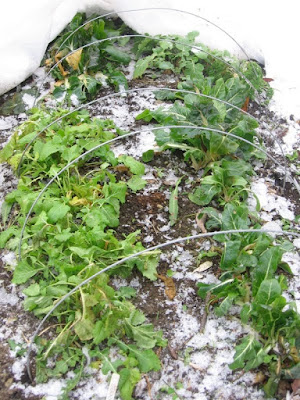
As the winter solstice nears and today's weather report indicates a wind chill of about 0 degrees, the ground is starting to freeze. But it's still possible to dig, especially in beds that have been covered with the plastic tunnels. Last weekend, I took out the leeks and carrots that were still out in the open and some of the turnips. This morning, I dug about half the remaining winter radishes. We'll mulch the remainder of the root vegetables heavily. If we haven't waited too long to mulch, we might be able to keep digging the remaining root vegetables for another month. Otherwise, they'll remain in the ground until early spring.

This weekend was also time to eat the last acorn squash and turn the stored pumpkins into soup. The pumpkins had been left on the front porch which, not surprisingly, is too cold for squash this time of year. They should have been moved into our unheated entryway several weeks ago. In fact, I just read that winter squash keep better at warmer temperatures (about 50 degrees), unlike root vegetables, which prefer much cooler conditions. The slightly frozen pumpkins were fine to cook, but they had to be used immediately. Now, in the form of 3 gallons of curried pumpkin soup, they'll last for many months more. The seeds, which we toasted, were gone immediately.

It’s one thing to read claims that communities in the northeast U.S. could produce most, if not all, the produce they need locally. It’s another to see it in action. Here’s what we’re eating mid-December:

From the garden:
Leeks
Jerusalem artichokes
Garlic scallions
Salad greens (mâche, claytonia, beet leaves, mustards, spinach, arugala)
Five kinds of Asian greens (for salads and stir fry)
Kale
Chard
Radishes (French & Daikon)
Carrots
Parsley
Sorrell
Winter savory
Thyme
Sage
Growing in the kitchen
Parsley
Bean sprouts (for salads and stir fry)
Rosemary

From cool storage
(Cool room or frig)
Beets
Garlic
Cabbage
Carrots
Winter radishes
Pickles
Horseradish relish
Dill & coriander (cilantro) seeds
From the freezer
String beans
Sugar-snap peas
Chard
Zucchini & yellow squash (stored as soup)
Pumpkin (stored as soup)
Blueberries and strawberries (picked from local farms at their peak and frozen whole)
Black-cap raspberries (frozen whole)
Peach compote
Basil, mint & garlic pestos
Bought from the market (local)
Apples & pears
Potatoes
Onions
Yams
Canned tomatoes and a few bananas are the only non-local produce needed this month. Usually, tomatoes would be in the freezer, but this summer’s early arrival of late blight destroyed most of the local crop (including our own), and limited potato yields as well. It will be a couple more years until our pear trees bear fruit, and even longer for our own apples (since we haven’t planted them yet.) And we still don't grow enough onions, winter squash and other root vegetables to get through entire the winter. But fortunately, local farmers have this covered.
As the above list shows, year-round local produce doesn’t rely on any one solution – canning, freezing, storing, or growing fresh. Nor is it a question of growing it all oneself versus buying from commercial farmers. Rather, it is a combination of all of the above. Some food (i.e., summer vegetables and fruits) is best canned or frozen when in abundance. Other veggies can be grown through the winter under cover. And still others are fall crops that store well or that can be cooked up and frozen as time allows.
Each year, we grow what we are able – limited by time, weather, space, and skill, and we are thankful to the community’s commercial farmers for the rest. We are not aiming for “self-sufficiency,” but rather finding our place in a local, inter-dependent community food system that can – and will – provide enough sustenance for all.


















































